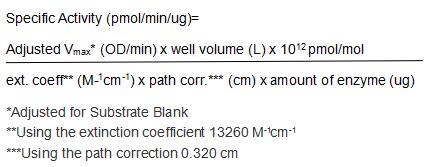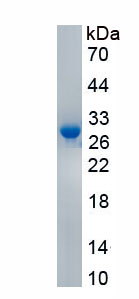Active Granzyme B (GZMB) 

GZM-B; HLP; CTLA1; CCPI; CGL1; CSP-B; CSPB; CTSGL1; SECT; Granzyme 2; Cytotoxic T-Lymphocyte-Associated Serine Esterase 1; Fragmentin 2; Cytotoxic Serine Protease B
- UOM
- FOB US$ 268.00 US$ 670.00 US$ 1,340.00 US$ 4,020.00 US$ 10,050.00
- Quantity
Overview
Properties
- Product No.APA600Po01
- Organism SpeciesSus scrofa; Porcine (Pig) Same name, Different species.
- ApplicationsCell culture; Activity Assays.
Research use only - DownloadInstruction Manual
- CategoryApoptosisTumor immunityInfection immunityImmune molecule
- Buffer FormulationPBS, pH7.4, containing 0.01% SKL, 5% Trehalose.
- Traits Freeze-dried powder, Purity > 90%
- Isoelectric Point10.2
Sign into your account
Share a new citation as an author
Upload your experimental result
Review

Contact us
Please fill in the blank.
Activity test

Granzyme B is a member of the granzyme family of the serine proteases found specifically in the cytotoxic granules of cytotoxic T lymphocytes (CTL) and natural killer (NK) cells. Granzyme B plays an essential role in granule-mediated apoptosis and may have additional roles in rheumatoid arthritis and in bacterial and viral infections. It activates various caspases and cleaves proteins such as aggrecan. The activity of recombinant pig Granzyme B was measured by its ability to cleaves a thioester substrate Z-Lys-SBzl•HCl. The reaction was performed in 0.05 M Tris, 0.15 M NaCl, 0.01% Triton X-100, pH 8.0 (Assay Buffer), initiated by addition 50 μL of various concentrations of GZMB (diluted by Assay Buffer) to 50 µL of 1.2 mM Substrate and DTNB mixture. The final well serves as a negative control with no GZMB, replaced with 50 μL assay buffer. Incubated at 25℃ for 5min, then read at a wavelength of 405 nm. The specific activity of recombinant pig Granzyme B is >440 pmol/min/µg.
Usage
Reconstitute in 10mM PBS (pH7.4) to a concentration of 0.1-1.0 mg/mL. Do not vortex.
Storage
Avoid repeated freeze/thaw cycles. Store at 2-8°C for one month. Aliquot and store at -80°C for 12 months.
Stability
The thermal stability is described by the loss rate. The loss rate was determined by accelerated thermal degradation test, that is, incubate the protein at 37°C for 48h, and no obvious degradation and precipitation were observed. The loss rate is less than 5% within the expiration date under appropriate storage condition.
Increment services
-
 BCA Protein Quantification Kit
BCA Protein Quantification Kit
-
 Molecular Mass Marker for Protein
Molecular Mass Marker for Protein
-
 Monoclonal Antibody Customized Service
Monoclonal Antibody Customized Service
-
 Polyclonal Antibody Customized Service
Polyclonal Antibody Customized Service
-
 Protein Activity Test Experiment Service
Protein Activity Test Experiment Service
-
 Electrophoretic Mobility Shift Assay (EMSA) Experiment Service
Electrophoretic Mobility Shift Assay (EMSA) Experiment Service
-
 Buffer
Buffer
-
 Lentivirus Packaging Experiment Service
Lentivirus Packaging Experiment Service
-
 Adenovirus Packaging Experiment Service
Adenovirus Packaging Experiment Service
-
 Real Time PCR Experimental Service
Real Time PCR Experimental Service
-
 Spike RBD Protein (S-RBD)
Spike RBD Protein (S-RBD)
-
 Protein G
Protein G
-
 Protein A
Protein A
Citations
- Effective immunotherapy of rat glioblastoma with prolonged intratumoral delivery of exogenous heat shock protein Hsp70Pubmed:24691976
- Z-100, an Immunomodulatory Extract of Mycobacterium tuberculosis Strain Aoyama B, Prevents Spontaneous Lymphatic Metastasis of B16-BL6 MelanomaPubmed:24818259
- Relationships among plasma granzyme B level, pruritus and dermatitis in patients with atopicdermatitis.pubmed:27686401
- Tumor-derived granzyme B-expressing neutrophils acquire antitumor potential after lipid A treatmentPubmed:29983866
- A novel Granzyme B nanoparticle delivery system simulates immune cell functions for suppression of solid tumorsPubmed: 31695790
- Combined treatment with epigenetic agents enhances anti-tumor activity of T cells by upregulating the ACRBP expression in hepatocellular carcinoma34377237







